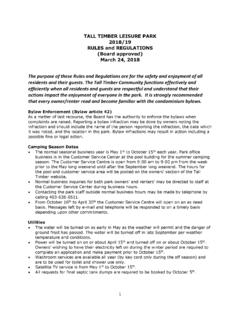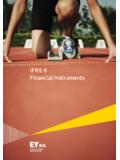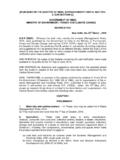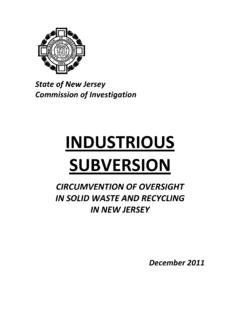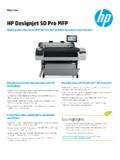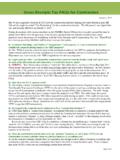Transcription of IFRS 9: Financial Instruments - EY
1 IFRS 9: Financial Instruments November 2016. Today's agenda Reminder of the new rules Key areas of impact Q&A. Page 2 EY European IFRS Power and Utilities Roundtable 2016. Reminder of the new rules Page 3. Problems with IAS 39 for power and utilities sector Belief that IAS 39 maintained some inconsistent rule- based measures Desire to achieve hedge accounting for economic hedges that have not been eligible for hedge accounting under IAS 39. Most of hedging activity for own use customer demand requirements but IAS 39 exemption not allowable for many contracts because of specific rules relating to net settlement Rigid 80%-125% test created some instances where hedge accounting could not be applied Hedges prohibited from being in hedging relationships despite being entered into to achieve valid risk management objectives Page 4 EY European IFRS Power and Utilities Roundtable 2016.
2 IFRS 9 and the power and utilities sector Power & utilities businesses undertake significant levels of hedging activity Predominantly to hedge price of gas and power required to meet end customer demand Fair value movements on contracts can be highly material Consistent support for move to more principles-based approach and better alignment of risk management and accounting As always, need to find right balance between needs of users of Financial statements and the costs of implementing Administering the hedge accounting principles of the Exposure Draft as it stands would still require a significant level of burden through expensive system upgrades and the employment of significant numbers of extra administrative staff, which would not add value to our business.. Company response to IASB ED on hedge accounting Page 5 EY European IFRS Power and Utilities Roundtable 2016.
3 Overview of the IFRS 9 project In July 2014, the International Accounting Standards Board (IASB). issued the final version of International Financial Reporting Standard (IFRS) 9 Financial Instruments to replace International Accounting Standard (IAS) 39 Financial Instruments : Recognition and Measurement The European Financial Reporting Advisory Group (EFRAG) has submitted its Endorsement Advice to the European Commission. EFRAG has recommended that all businesses in the European Union (EU) should be required to account for their Financial Instruments in compliance with IFRS 9 as of 2018. Early application is permitted EU endorsement is expected in Q4 2016. Page 6 EY European IFRS Power and Utilities Roundtable 2016. Classification and measurement (assets) . overview Debt (including hybrid contracts) Derivatives Equity Contractual cash flow characteristics test (at instrument level).
4 Pass Fail Fail Fail Held for Business model test (at an aggregate level). trading? Hold-to-collect Neither (1). 1 contractual 2 BM with objective that results in collecting 3 nor (2) Yes No cash flows contractual cash flows and selling Financial assets No FVOCI option Conditional fair value Yes elected ? option (FVO) elected? No No Yes Amortized FVOCI FVOCI. FVPL. cost (with recycling) (no recycling). Page 7 EY European IFRS Power and Utilities Roundtable 2016. Some observations from implementation of IFRS 9 (Phase 1) in the industry Assessment of the business model thought through but often not yet documented or finalized Rarely multiple business models SPPI-Test Generally not much of an issue for the industry; however, embedded derivatives no longer separated for Financial assets Specific facts and circumstances give rise to FVPL accounting from time to time Equity Instruments Strategy?
5 : item-by-item choice increasing importance in Energiewende Page 8 EY European IFRS Power and Utilities Roundtable 2016. Some observations from implementation of IFRS 9 (Phase 1) in the industry Debt/equity issues noted Non-consolidated shares in Instruments under the puttables amendment may not qualify for the accounting choice for equity Instruments (BC ), : German KG. Interests in investment funds Own use: contract-by-contract fair value choice (IFRS ). Irrevocably available at inception if it eliminates or significantly reduces a recognition inconsistency May help avoiding hedge documentation Does not seem to be considered often in current implementations Page 9 EY European IFRS Power and Utilities Roundtable 2016. Impairment: the general approach Start here Loss Stage 1 Stage 2 Stage 3.
6 Allowance updated 12-month Lifetime Lifetime at each expected credit expected credit expected credit reporting date losses losses losses Lifetime Credit risk has increased significantly since expected initial recognition (individual or collective basis). credit losses +. criterion Credit-impaired Interest Effective interest rate Effective interest rate Effective interest rate revenue on gross carrying on gross carrying on amortized cost calculated amount amount based on Change in credit risk since initial recognition Improvement Deterioration Page 10 EY European IFRS Power and Utilities Roundtable 2016. Some observations from implementation of IFRS 9 (Phase 2) in the industry Simplified approach dominating implementation discussion How to determine adequate portfolios How to derive adequate disclosures (and reporting) under the IFRS 9 requirements Legal issues around contract assets prepayments/deposits treated differently from (unbilled) receivables or netted/embedded as collateral?
7 Lease receivables: accounting choice to consider lifetime expected losses (separately available to finance vs. operating leases). Page 11 EY European IFRS Power and Utilities Roundtable 2016. Some observations from implementation of IFRS 9 (Phase 2) in the industry General approach Often limited number of items portfolio-based assessment often not feasible Difficulty in gathering market credit risk information on several counterparties internal ratings used, increasing use of credit risk information by credit agencies observable Assumption of when credit risk increased significantly changes within investment grade often considered to have no significant change ( ). 30 days past due rebuttable assumption Page 12 EY European IFRS Power and Utilities Roundtable 2016. Carrying values of impaired Financial assets Definition of Gross carrying value IFRS Transition Resource Group for Impairment of Financial Instruments (ITG) members recognized that IAS.
8 ? 39 does not provide specific guidance and, in practice, different approaches are observable Example: impaired Financial asset with amortized ITG members agreed on Method A as the cost of CU100 at an effective interest rate of 10% only method in line with IFRS 9, since IFRS. 9 now provides for a definition of the gross As of 31 December 20X1, an impairment of CU60 carrying value. Under Method A, an entity was accounted for needs to determine the following: During 20X2 no changes occurred. Therefore, the 1. The gross carrying value through amortized cost at 31 December 20X2 is 44WE discounting of the estimated contractual (40WE+ [40WE X 10%]) cash flows using the initial effective interest rate Method A B C. Gross carrying value 110 104 100 2. The impairment reserve through discounting of the expected negative Impairment reserve (66) (60) (56).
9 Payment differences using the initial Amortized cost 44 44 44 effective interest rate Page 13 EY European IFRS Power and Utilities Roundtable 2016. Hedge accounting Overview of key changes Requirement IAS 39 IFRS 9. Risk component as eligible hedged item Financial Items All Items Hedging of aggregated exposures X . 80%-125% test X. Retrospective effectiveness testing X. Quantitative effectiveness test Depends Qualitative effectiveness test X Depends Rebalancing of hedge ratio X . Accounting for costs of hedging X . Dedesignation (risk management objective X. unchanged). Fair value option for own use contracts . Page 14 EY European IFRS Power and Utilities Roundtable 2016. Some observations from implementation of IFRS 9 (Phase 3) in the industry Implementation as the first step, optimization may follow Software availability may hinder early application Challenges related to measurement and accounting for parts of the fair values ( , FX basis spreads) software availability perceived as bottleneck Technical issues discussed include the following: Sub-LIBOR issue Risk components Rebalancing how frequently to perform?
10 Which threshold? Measurement issues how to derive basis spreads? Page 15 EY European IFRS Power and Utilities Roundtable 2016. Q&A. Page 16. Thank you Page 17. EY | Assurance | Tax | Transactions | Advisory Ernst & Young LLP. 2015 Ernst & Young LLP. Published in the UK. All Rights Reserved. The UK firm Ernst & Young LLP is a limited liability partnership registered in England and Wales with registered number OC300001 and is a member firm of Ernst & Young Global Limited. Ernst & Young LLP, 1 More London Place, London, SE1 2AF.










